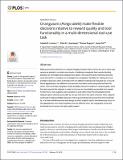Files in this item
Orangutans (Pongo abelii) make flexible decisions relative to reward quality and tool functionality in a multi-dimensional tool-use task
Item metadata
| dc.contributor.author | Laumer, Isabelle B. | |
| dc.contributor.author | Auersperg, Alice M. I. | |
| dc.contributor.author | Bugnyar, Thomas | |
| dc.contributor.author | Call, Josep | |
| dc.date.accessioned | 2019-02-14T11:30:05Z | |
| dc.date.available | 2019-02-14T11:30:05Z | |
| dc.date.issued | 2019-02-13 | |
| dc.identifier | 257303871 | |
| dc.identifier | ef9f5b88-c64c-49a8-9e9e-4515822c4786 | |
| dc.identifier | 85061488499 | |
| dc.identifier | 000458761300026 | |
| dc.identifier.citation | Laumer , I B , Auersperg , A M I , Bugnyar , T & Call , J 2019 , ' Orangutans ( Pongo abelii ) make flexible decisions relative to reward quality and tool functionality in a multi-dimensional tool-use task ' , PLoS ONE , vol. 14 , no. 2 . https://doi.org/10.1371/journal.pone.0211031 | en |
| dc.identifier.issn | 1932-6203 | |
| dc.identifier.other | ORCID: /0000-0002-8597-8336/work/54181540 | |
| dc.identifier.uri | https://hdl.handle.net/10023/17065 | |
| dc.description | This work was supported by the University of St Andrews and the Max Planck Institute for Evolutionary Anthropology. Isabelle Laumer was supported by a uni:docs fellowship of the University of Vienna, Alice Auersperg was supported by by FWF grants J 3404-B19 and P 29084, and Thomas Bugnyar by Y366-B17. | en |
| dc.description.abstract | Making economic decisions in a natural foraging situation that involves the use of tools, may require an animal to consider more levels of relational complexity than merely deciding between an immediate and a delayed food option. We used the same method previously used with Goffin´s cockatoos to investigate the orangutans’ flexibility for making the most profitable decisions when confronted with five different settings that included one or two different apparatuses, two different tools and two food items (one more preferred than the other). We found that orangutans made profitable decisions relative to reward quality, when the task required the subjects to select a tool over an immediately accessible food reward. Furthermore, most subjects were sensitive to work-effort when the immediate and the delayed option (directly accessible by using a tool) led to the same outcome. Most subjects continued to make profitable decisions that required taking into account the tool functionality. In a final multidimensional task design in which subjects had to simultaneously focus on two apparatuses, two reward qualities and two different tools, the orangutans chose the functional tool to access the high quality reward. | |
| dc.format.extent | 13 | |
| dc.format.extent | 1368605 | |
| dc.language.iso | eng | |
| dc.relation.ispartof | PLoS ONE | en |
| dc.subject | Decision making | en |
| dc.subject | Behavioural flexibility | en |
| dc.subject | Impulse control | en |
| dc.subject | Tool use | en |
| dc.subject | Ape cognition | en |
| dc.subject | BF Psychology | en |
| dc.subject | NDAS | en |
| dc.subject.lcc | BF | en |
| dc.title | Orangutans (Pongo abelii) make flexible decisions relative to reward quality and tool functionality in a multi-dimensional tool-use task | en |
| dc.type | Journal article | en |
| dc.contributor.institution | University of St Andrews. Centre for Social Learning & Cognitive Evolution | en |
| dc.contributor.institution | University of St Andrews. School of Psychology and Neuroscience | en |
| dc.identifier.doi | 10.1371/journal.pone.0211031 | |
| dc.description.status | Peer reviewed | en |
| dc.date.embargoedUntil | 2019-02-13 |
This item appears in the following Collection(s)
Items in the St Andrews Research Repository are protected by copyright, with all rights reserved, unless otherwise indicated.

